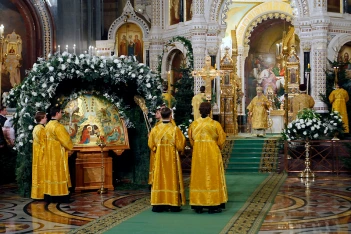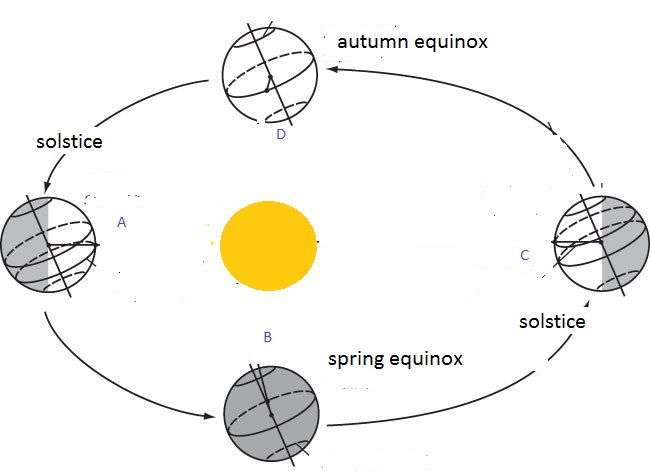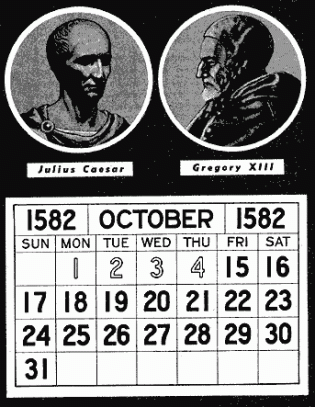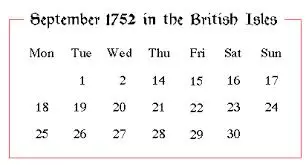Merry Christmas to all my readers and followers and I wish you all a happy New Year.
The majority of people who celebrate Christmas Day, whether for religious or cultural reasons or both, do so on 25 December. However, followers of the Orthodox churches generally celebrate Christmas Day thirteen days later, on January 7. The reasons for this difference are interesting and, as I’ll discuss further in this post, are to do with both astronomical measurement and also disagreements between different branches of the Christian church.
The solar year
One of the most fundamental units of time is a the year. A solar year is the term used by astronomers to describe the amount of time that the Sun takes to return to exactly the same position in the cycle of the seasons. This has been accurately measured as 365.2421897 days, to the nearest 7 decimal places.
A solar year is the amount of time from a particular point in the cycle of the seasons to exactly the same point in the following year (e.g from one summer solstice to next or from one spring equinox to the next)
Because a solar year is slightly longer than 365 days, if we were to use a calendar where every year always had exactly 365 days, then the calendar year would slowly run ahead of the solar year at the rate of slightly less than a quarter of a day per year. In about 400 years the calendar would have drifted away from the seasons by about 97 days. So, in the northern hemisphere, the start of spring would be at the end of June, the summer solstice (the day of the year with the most daylight) would be at the end of September and the autumn (or fall) equinox would be at the end of December. To prevent this happening we add an extra day (February 29) every four years. When this happens it is a leap year.
Having a leap year every four years is a key feature of the Julian calendar, named after Julius Caesar, who introduced it in the year 45 BCE, which was used by all Christian countries until 1582. However, if we always have a leap year every four years, this will result in a year which is on average 365.25 days long, which is 0.078 days longer than the actual length of a solar year. This slight over correction causes the Julian calendar to drift backwards gradually from the natural calendar by 7.8 days per 1000 years .
Between 325, when the Julian calendar was first used by the church to define the date of Easter, and 1582, it had drifted back by 10 days. So in that year the spring equinox, the first day of spring, when the day and night are roughly 12 hours long, was on March 11 (whereas in 325 it had been on March 21), the day which had the most daylight was Jun 11 and the shortest day was December 11. The spring equinox is used to calculate Easter (see note 1) so the date range on which Easter could fall had drifted back by 10 days.
The Gregorian Calendar
In 1582 Pope Gregory XIII introduced a refinement to prevent the calendar used by the church from drifting any further away from the natural calendar. The change he made was that a century year (e.g. 1600, 1700, 1900, 2000, 2100) could only be a leap year if it was divisible by 400. So 1700, 1800, 1900 would not be not leap years, but 1600 and 2000 would be. He also proposed that the calendar be brought back in line with the seasons so the spring equinox would once again fall on March 21. This required that 10 days be omitted when moving from the old to the new calendar. Pope Gregory’s calendar, which is the one that nearly every country in the world uses today, is called the Gregorian calendar. On average each year is 365.2425 days, which is very close to the length of the solar year.
The Gregorian calendar was quickly adopted by the Catholic countries in Europe. Spain, which at the time included Portugal and much of Italy, adopted it on 4 October 1582. In Spain the day after 4 October 1582 was 15 October 1582, with the days from 5 October to 14 October being simply missed out.
Initially, the Protestant and Orthodox countries in Europe refused to adopt the Gregorian calendar, feeling that it was a plot by the Catholic church to impose its power over non-Catholic countries. This caused confusion over dates when some countries had converted to the Gregorian Calendar and other countries still used the Julian Calendar. Conventions such as 10/20 February 1667 were used to indicate that an event took place on 10 February 1667 in the Julian Calendar, which was the same day as 20 February 1667 in the Gregorian Calendar.
The whole of Europe adopts the Gregorian calendar
Eventually, all the Protestant countries switched over to the Gregorian Calendar. In particular, Great Britain and its colonies, which at the time included America, adopted the Gregorian calendar on Wednesday 2 September 1752, which was followed by Thursday 14 September 1752. The eleven days from 3 September to 13 September were missed out.
According to some accounts rioters took to the streets, demanding that the government “give us back our 11 days.” In America, meanwhile, Benjamin Franklin (1705-1790) took a more positive view of the phenomenon and wrote that “it is pleasant for an old man to be able to go to bed on September 2, and not have to get up until September 14”.
The Orthodox countries of Eastern Europe were even slower to adopt the Gregorian calendar. The Soviet Union didn’t adopt it until in 1918 and Greece didn’t adopt until 1923.
Interestingly, even though all the Orthodox countries have adopted the Gregorian calendar for civil purposes, most Orthodox churches still use the Julian calendar and will not accept a calendar which they see as being imposed by the Catholic church. So, allthough Orthodox Christians do celebrate their Christmas on the day marked December 25 on their calendars, they are celebrating on a completely different day to the rest of the Christian world, as it is actually January 7 in the Gregorian calendar.
Calendars in other Countries in the World
Nearly all countries of the world use the Gregorian calendar for administrative purposes, sometimes alongside a more traditional calendar. For example, China uses the Gregorian calendar for public or business affairs such as most national holidays, but uses the traditional Chinese calendar, in which years have names rather than numbers, as well. In the Chinese calendar there can be 353, 354, 355 383, 384, or 385 days in a year and the first day of the new year occurs in late January or February. The current year runs from 8 February 2016 to 27 January 2017 and is the year of the monkey. The Chinese New Year on 28 January 2017 will be start of the year of the rooster.
What will happen in the future ?
The Julian Calendar is slowly drifting away from the natural calendar at the rate of 7.8 days per thousand years, so if the Orthodox church doesn’t adopt the Gregorian calendar then the date of Orthodox Christmas will get later and later. In 2,000 years time Orthodox Christians would be celebrating Christmas on around January 23 (in the Gregorian calendar) and in 10,000 years time they would be celebrating Christmas at the end of March.
As mentioned previously, the average length of a year in the Gregorian calendar is 365.2425 days and the length of a solar year is 365.2421897. So even the Gregorian calendar is only an approximation to the “real year” and gives a very slight over-correction. To bring the Gregorian calendar into line with the natural calendar it will be necessary to omit a day every 3,200 years.
On that final note I’ll sign off and wish you all a healthy and happy 2017!!
Note
This is described in more detail in my post Easter – 27 March 2016.







[…] talked about in my earlier put up Christmas Day – December 25th or January 7th? , most Orthodox church buildings nonetheless use the Julian Calendar and won’t settle for a […]
LikeLike
[…] mentioned in my earlier post Christmas Day – December 25th or January 7th? , most Orthodox churches still use the Julian Calendar and will not accept a calendar which they […]
LikeLike
Reblogged this on Those Three Writers.
LikeLike
I know that difference and reason of it 🙂 Interesting post.
I leave you my post about celebration of New Year’s Eve in Madrid
https://traveltomeetyourheart.wordpress.com/2017/01/07/12-grapes-new-years-eve-spain-madrid/
LikeLike
Nice post, although I am an Orthodox Christian living in Greece and in Greece we all celebrate Christmas on the 25th like everyone else and we also have the same calendar as everyone else.. I can’t tell you about Orthodox Christians but I don’t know about Orthodox Christians in other countries.. 🙂
LikeLiked by 1 person
For a blog to have such conflicting interests, when it comes to god? i found your post very enlightening…
i also see that you stopped by for a read,
methanks!
chris
LikeLike
i found it very impressive there was no moderation!
LikeLike
Thank you
LikeLiked by 1 person
Very interesting thoughts. Have you looked to see when Jesus was actually born?
LikeLiked by 1 person
Annunciation Day – March 25th or April 7th? As Mary’s birthday is September 8th (or October 8th?) the date of January 7th does not matter for Mary’s age on the very first Annunciation Day: 12, when Gabriel told her the news. I sincerely hope that 2017 will be a better year for the children all over the world.
LikeLike
EMEGHERD!!! … It would’ve been so much easier if they’d stuck to the Solstices and Equinoxes!!! … but all those nasty ‘pagans’ had cornered the market on those so they had to make up their own.
LikeLike
Very well written, I learned a lot! Thank you, you’re a wonderful teacher!
LikeLiked by 1 person
Thank you
LikeLiked by 1 person
Reblogged this on Dr. Mohsen Behnam.
LikeLiked by 1 person
Reblogged this on Splattered Brains and commented:
Interesting how we get all wrapped up around the concepts of time in order to make our systems work. But time is not perfect.
LikeLiked by 1 person
Excellent writeup!
LikeLiked by 1 person
Thank you
LikeLiked by 1 person
So in effect the Orthodox do not celebrate Christmas on 7th January, but on 25th December, like everyone else. They just use a different calendar
.
LikeLiked by 1 person